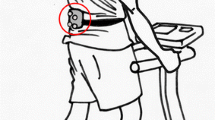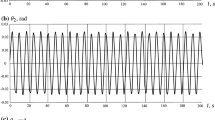Abstract
The proposed strap-down integration method exploits the cyclical nature of human gait: during the gait swing phase, the quaternion-based attitude representation is integrated using a gyroscope from initial conditions that are determined during stance by an accelerometer. Positioning requires double time integration of the gravity-compensated accelerometer signals during swing. An interpolation technique applied to attitude quaternions was developed to improve the accuracy of orientation and positioning estimates by accounting for the effect of sensor bias and scale factor drifts. A simulation environment was developed for the analysis and testing of the proposed algorithm on a synthetic movement trajectory. The aim was to define the true attitude and positioning used in the computation of estimation errors. By thermal modelling, the changes of bias and scale factor of the inertial sensors, calibrated at a single reference temperature, were analysed over a range of ±10°C, for measurement noise standard deviations up to σg = 2.5° s−1 (gyroscope) and σa = 0.05 m s−1 (accelerometer). The compensation technique reduced the maximum root mean square errors (RMSEs) to: RMSEθ=14.6° (orientation) and RMSEd=17.7 cm (positioning) for an integration interval of one gait cycle (an improvement of 3° and 7 cm); RMSEθ=14.8° and RMSEd=30.0 cm for an integration interval of two gait cycles (an improvement of 11° and 262 cm).
Similar content being viewed by others
References
Abbott, E., andPowell, D. (1999): ‘Land-vehicle navigation using GPS’,Proc. IEEE,87, pp. 145–162
Aminian, K., Rezakhanlou, K., Andres, E. D., Fritsch, C., Levyraz, P.-F., andRobert, P. (1999): ‘Temporal feature estimation during walking using miniature accelerometers: an analysis of gait improvement after hip arthroplasty’,Med. Biol. Eng. Comput.,37, pp. 686–691
Aminian, K., Najafi, B., Büla, C., Levyraz, P.-F., andRobert, P. (2002): ‘Spatio-temporal parameters of gait measured by an ambulatory system using miniature gyroscopes’,J. Biomech.,35, pp. 689–699
Analog Devices, Inc. (1999): ‘ADXL210E Technical Data Sheet’. http://www.analog.com
Bachmann, E. R. (2000): ‘Inertial and magnetic tracking of limb segment orientation for inserting humans in synthetic environments’. PhD thesis, Naval Postgraduate School, Monterrey, CA, USA
Barshan, B., andDurrant-Whyte, H. F. (1994): ‘Evaluation of a solid-state gyroscope for robotics applications’,IEEE Trans. Instrum. Meas.,44, pp. 61–67
Bortz, J. E. (1971): ‘A new mathematical formulation for strapdown inertial navigation’,IEEE Trans. Aerosp. Elec. Syst.,7, pp. 61–66
Bussmann, J. B. J., Veltink, P. H., Koelma, F., Van Lummel, R. C., andStam, H. J. (1995): ‘Ambulatory monitoring of mobility-related activities: the initial phase of the development of an activity monitor’,Eur. J. Phys. Med. Rehab.,5, pp. 2–7
Chou, J. C. K. (1992): ‘Quaternion kinematic and dynamic differential equations’,IEEE Trans. Rob. Automat.,8, pp. 53–64
Ferraris, F., Grimaldi, U., andParvis, M. (1995): ‘Procedure for effortless in-field calibration of three-axis rate gyros and accelerometers’,Sensors Mater.,7, pp. 311–330
Guillemaud, R., Caritu, Y., David, D., Favre-Réguillon, F., Fontaine, D., andBonnet, S. (2003): ‘Body motion capture for activity monitoring’.Int. Workshop on New Generation of Wearable Systems for eHealth, Dec. 11–14, Castelvecchio Pascoli, Lucca, Italy
Kirtley, C. (2001): ‘Summary: Quaternions vs. Euler angles’. BIOMCH-L Discussion, May 3, 2001, http://isb.ri.ccf.org/ biomch-1/archives/biomch-1-2001-05
Lötters, J. C., Schipper, J., Veltink, P. H., Olthius, W., andBergveld, P. (1998): ‘Procedure for in-use calibration of triaxial accelerometers in medical applications’,Sensors Actuators A,68, pp. 221–228
Luinge, H. J. (2002): ‘Inertial sensing of human movement’. PhD thesis, University of Twente, Twente University Press, Enschede, The Netherlands
Mayagoitia, R. E., Nene, A. V., andVeltink, P. H. (2002): ‘Accelerometer and rate gyroscopes measurement of kinematics: an inexpensive alternative to optical motion analysis systems’,J. Biomech.,35, pp. 537–542
Miyazaki, S. (1997): ‘Long-term unrestrained measurement of stride length and walking velocity utilizing a piezoelectric gyroscope’,IEEE Trans. Biomed. Eng.,44, pp. 753–759
Murata Manufacturing Co., Ltd. (1999): ‘Data sheet of Gyrostar® Model: ENC-03JA ENC-03JB’, http://www.murata.com
Ohtaki, Y., Sagawa, K., andInooka, H. (2001): ‘A method for gait analysis in a daily living environment by body-mounted instruments’,JSME Int. J.,44, pp. 1125–1132.
Pappas, I. P. I., Keller, T., andPopovic, M. R. (1999): ‘Experimental evaluation of the gyroscope sensor used in anew gait phase detection system’,Proc. 4th Ann. Conf. Int. Functional Electrical Stimulation Society, August 23–27, Sendai, Japan, pp. 12–16
Pappas, I. P. I., Popovic, M. R., Keller, T., Dietz, V., andMorari, M. (2001): ‘A reliable gait phase detection system’,IEEE Trans. Rehab. Eng.,9, pp. 113–125
Sabatini, A. M., Martelloni, C., Scapellato, S., andCavallo, F. (2004): ‘Assessment of walking features from foot inertial sensing’,IEEE Trans. Biomed. Eng., in press
Shoemake, K. (1985): ‘Animating rotations with quaternion curves’.Proc. SIGGRAPH 85, ACM Press, pp. 245–254
Veltink, P. H., Bussmann, H. B. J., De Vries, W., Martens, W. L. J., andVan Lummel, R. C. (1996): ‘Detection of static and dynamic activities using uniaxial accelerometers’,IEEE Trans. Rehab. Eng.,4, pp. 375–385
Veltink, P. H., Slycke, P., Hemssems, J., Buschman, R., Bulstra, G., andHermens, H. (2003): ‘Three dimensional inertial sensing of foot movements for automatic tuning of a two-channel implantable drop-foot stimulator’,Med. Eng. Phys.,25, pp. 21–28
Verplaetse C. (1996): ‘Inertial proprioceptive devices: self-motion-sensing toys and tools’, IBM Systems Journal,35(3–4), pp. 639–650
Williamson, R., andAndrews, B. J. (2001): ‘Detecting absolute human knee angle and angular velocity using accelerometers and gyroscopes’,Med. Biol. Eng. Comput.,39, pp. 294–302
Wu, G., andLadin, Z. (1996): ‘The study of kinematic transients in locomotion using the integrated kinematic sensor’,IEEE Trans. Rehab. Eng.,4, pp. 193–200
Author information
Authors and Affiliations
Corresponding author
Rights and permissions
About this article
Cite this article
Sabatini, A.M. Quaternion-based strap-down integration method for applications of inertial sensing to gait analysis. Med. Biol. Eng. Comput. 43, 94–101 (2005). https://doi.org/10.1007/BF02345128
Received:
Accepted:
Issue Date:
DOI: https://doi.org/10.1007/BF02345128




